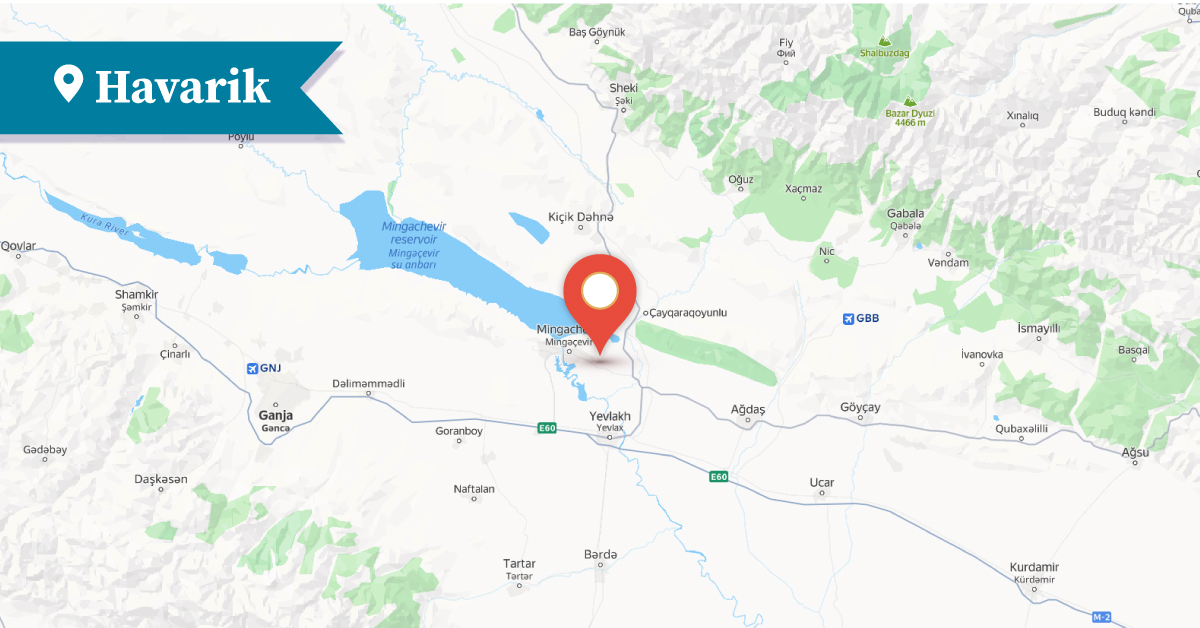2025
2025
2025-09-08

The ancient Armenian Havarik[1] village is located in Aghdash district formed in 1930, in areas adjacent to Kura river. The settlement is located 33.2 km northwest of the district center Aghdash (formerly known as Kaghaberd). Administratively, in the second half of the 19th century and the beginning of the 20th century, the village was part of the Aresh district of the Elizavetpol governorate.
Before the riverbed was changed, the Kura River flowed through the territory of the village. There is preserved information that on May 15, 1896, due to the rising waters of the river, most of the houses in the villages of Akcham, Havarik, Hajiselli, and Mazrghu collapsed, and the orchards were destroyed.
The population of Havarik mainly consisted of locals, who had their own distinct dialect. Only 10 households in the village had moved there from Artsakh.
In 1841, Havarik had 43 households with 283 Armenian inhabitants, and in 1851—52 households with 403 inhabitants. By 1888, the number of Armenian residents had grown to 752, and by 1901—to 800 people. In 1905, the village was home to 888 Armenians. By 1908, however, the number of Armenians had decreased to 490.
According to the 1914 statistical data, 790 Armenians lived in the village, while in 1917–1918 it had 250 Armenian households.
For many years, Havarik had a parish school, which was opened in 1870. Children from neighboring Armenian villages, such as Qandak and Mazrghu, also attended the school. However, because of inadequate facilities, the school was occasionally forced to close temporarily.
Havarik suffered greatly during the Armenian-Tatar clashes of 1905–1906: the village was devastated, and part of the population was killed.
The villagers rebuilt the settlement, but in 1918 it was once again destroyed by Ottoman troops marching toward Baku, together with Tatar armed bands that had joined them. Only 28 residents survived the massacres, while around 1,000 people were killed. After the establishment of Soviet rule in Azerbaijan, a few surviving Havarik families returned to their native village. During that time, the residents even attempted to reopen the school. However, after some time, they too left, and the village was finally emptied of Armenians. Later, Turkic-speaking settlers established themselves there.
The village had the church Holy Mother of God, first mentioned in records from 1841. In 1870, the villagers of Havarik built a new church to replace the old, dilapidated one, and it too bore the name Holy Mother of God. A reference to the church notes that it “...with its beautiful exterior and the marvelous arched interior columns, could be on par with the churches of Nukha.”
The church was looted and damaged in 1906 during the Armenian-Tatar clashes. Havarik’s priest, Sahak Ter-Poghosyants, left a record stating: “Every effort was made to destroy the church of Havarik...” After these events, the church was repaired. In the Soviet period, in 1923, the still-standing church building was repurposed into a school.
When Samvel Karapetyan visited the village in 1987, he found that both the church of Havarik and the Armenian cemetery had been demolished by Azerbaijanis.
It is also known that in 1863, the scribe Grigor copied the manuscript Taghkʿ (“Canticles”) in Havarik.
The renowned poet, translator, and researcher of the Aresh[2] dialect Ashot Gharagyozyan (Ashot Lusents) was born in the village.
Today, the village is inhabited by Azerbaijanis.
Bibliography
Letter from Arash district, Mshak, 1896, No. 63, June 1, p. 3.
Priest Sahak Ter-Poghosyan, The Churches of Five Villages of Arash, Mshak, 1906, No. 134, June 22, p. 3.
Lusents, A. Gh., The Arash Dialect, Yerevan, 1982, 271 pp.
Bishop Makar Barkhutaryants. The Land of Aghvank and Its Neighbors. Artsakh. Yerevan, 1999, p. 142.
Karapetyan, S., Aghvank Proper, Part 1, Yerevan, 2024, pp. 22-25.
[1] Havarik. Havarli in Azerbaijani
[2] Aresh dialect is also known as Havarik dialect